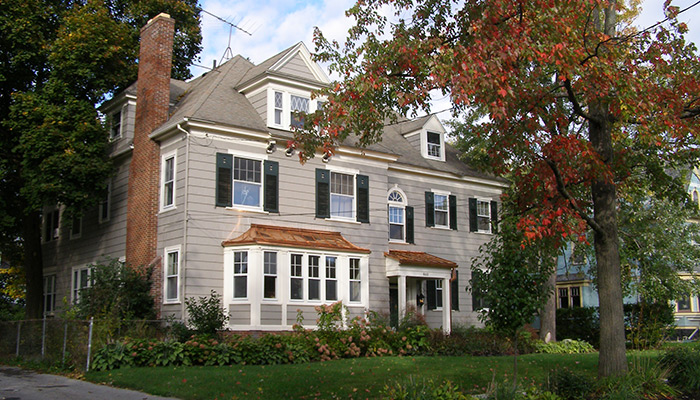The home now numbered as 460 Allen Street was first occupied in 1904 by Mr. and Mrs. Charles P. Gould (the address was actually 418 Allen at this time, changed to 460 in 1912). Mr. Gould was a commercial traveler, often away during the workweek, returning to Syracuse on Friday nights. Mrs. Gould was the daughter of James Pennock, developer of the tract of land that included Allen Street south of Genesee and north of Harvard. The 1905 City Directory lists Mrs. Gould as removed to Denver. However, the couple did return to Syracuse and to Allen Street.
The house sits on a double lot. The original part of the house, the left side as you face it, was built as an American Foursquare and probably had a full-width porch with an entry on the right side of the porch. This would have led to a hallway and stairs with a sitting room to the left, the dining room behind that (where the current office is), and a small kitchen to the right of the dining room and behind the entry, completing the square. There were four bedrooms on the second floor and a rear staircase that led to the maid’s quarters in the attic.
The house was enlarged after the time the Shattucks acquired it in 1917 (see below). Local lore is that Frank’s brother had a more substantial home on Allen, his parents owned a mansion around the corner on Genesee, and Frank rebuilt the home in keeping with the family image. The addition was built on the northern or right hand lot.
The transformed house reflects the Colonial Revival style with the symmetrical layout of the façade, the horizontal clapboard siding, the three- window dormer, and a large arched window. The addition opened up the interior and changed the flow of the house from front-to-back to side-to-side. The original foursquare interior was substantially redone, creating the full-width living room by removing the entry and original stairway. At this time, the massive bay at the front of the house was added after the porch was removed. It’s not clear whether the two-story “porch” section at the back of the house was added at this time or may have been part of the original house. The new addition included a more impressive entry and staircase, a larger dining room, and a larger kitchen, as well as a master bedroom suite on the second floor.
Innes Henry was owner of the house from 1905 to 1915. He was a manager at Mason Press and later president and manager of Mason Henry Press. Frederick Housinger lived here in 1916 and 1917. The home’s most famous resident, Frank M. Shattuck , moved in in 1917.
Frank M. Shattuck
Frank M. Shattuck was the 29-year-old son of Frank G. Shattuck, the founder and chairman of the board of the Frank G. Shattuck Company, a twenty million dollar a year business that operated Schrafft’s candy stores and restaurants. The older Mr. Shattuck began his life in Durhamville, New York.
A June 7, 1925 Syracuse Herald article states,
“America’s millions today are reaping the harvest of an idea which originated a half a century ago in the not far distant little village of Durhamville, Oneida County, as a little lad on tiptoes peeped over the table edge to watch his mother making pastries and good things to eat in the spotless kitchen of her little home.”
Frank G. Shattuck left Durhamville for New York City at eighteen where he worked on a tugboat, obtained a clerkship in a law firm, and finally found his true calling in merchandising. While working as a candy salesman, he tasted chocolates manufactured by W. Schrafft & Son, Boston. They were so good that he quit his job and went to work for Schrafft’s. He organized wholesale agencies throughout the country and when he opened his first store in New York City he kept the Schrafft’s name because he was selling their candies.
As an adult he remembered the delights of his mother’s kitchen and the indigestion that resulted from ill-cooked foods in restaurants. He resolved to reproduce his mother’s kitchen for the general public. To that end, his sister Miss Jane Shattuck entered the business, and the stores began to serve food cooked according to the old Shattuck family recipes. This very successful plan resulted in 43 stores that served 100,000 people a day and did a sales volume of twenty million dollars. He lived in Syracuse from the time he opened his first store in Syracuse in 1906, until 1921. When he died in 1937, he was well respected among the business elite as one of the greatest salesmen in America in the confectionary lines and as an organizer of business on a big scale. In a 1925 Herald article he was quoted as saying, “If you think life is a jolly old proposition, it turns out to be so. If you think it is a dismal institution, you’ll probably be a dyspeptic. For the dismal, I recommend candy. A grouch and candy are impossible companions.”
The younger Mr. Shattuck was born in Oneida in 1888, moved to Syracuse in 1907, and lived in the city until his death in 1959. He married Genevieve Hannon in 1913 and moved into the home at 460 Allen in 1917. He managed the Schrafft’s store in Syracuse for more than forty years, also serving on the board of directors and as a principal company advisor. Genevieve Hannon Shattuck and Frank M. Shattuck had five children: Gerald, Frank, George, Genevieve, and Eudora, all of whom were born in the upstairs master bedroom on Allen Street. Mrs. Shattuck was described as a woman who liked to stay put. She lived in the house on Allen Street from 1917 until her death at age 98 in 1988. Frank M. Shattuck was 71 when he died on September 2, 1959 at his country home.
